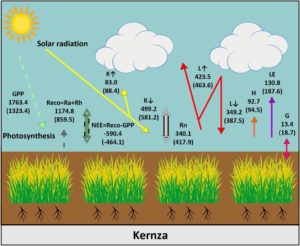Carbon and water relations in perennial Kernza®
Perennial crops, like Kernza® varieties of intermediate wheatgrass, have been proposed as a more sustainable alternative to annual crops, because they have extended growing seasons, continuous ground cover, reduced nutrient leakage, and sequester more carbon in the soils than annual crops. In a recently published Plant Science paper, researchers dive deeper into t he water and carbon use relationships in Kernza® varieties.
he water and carbon use relationships in Kernza® varieties.
The paper was developed by researchers from the University of Kansas, The Land Institute, and the Swedish University of Agricultural Sciences. It provides a comprehensive framework for the water and carbon cycles in Kernza® varieties by reviewing findings related to water-use efficiency, evapotranspiration patterns, and net carbon uptake rates.
In order to evaluate the water and carbon use relationships in Kernza® varieties, past studies have focused on the available energy at the surface. Findings indicate that year-round vegetative cover translates to a higher availability of energy for the plant. This energy is utilized when a plants’ needs are at a maximum, most commonly at the onset of the growing season or the summer. Continuous ground cover and robust root systems combine to make Kernza® varieties highly water-efficient. Fields experience low surface runoff, which allows them to recharge deep water, although researchers point out that this is dependent on location and soil. Thus, Kernza® production presents an interesting dynamic of water consumption that allows water and nutrient use to be relatively efficient throughout the whole growing season, even when evaporative losses tend to dry out the topsoil.
In addition to evapotranspiration and water-use efficiency, the authors explore carbon uptake rates. Kernza® varieties have been shown to act as a carbon sink. However, depending on the amount of biomass removed by harvest, the sink can be shifted towards being carbon neutral or a carbon source. In order to fully understand the net carbon balance in Kernza® agroecosystems, the authors suggest a comparative analysis between Kernza® and different annual crops.
In sum, this paper offers a valuable framework for investigating the physical and biological aspects involving the water and carbon cycles in perennial Kernza® plants. However, future research is necessary, focused particularly on water use and carbon allocation, the responses of Kernza® varieties to extreme growing conditions, the effects of land cover conversion to Kernza® production, and an in-depth assessment of carbon sink in Kernza® varieties.